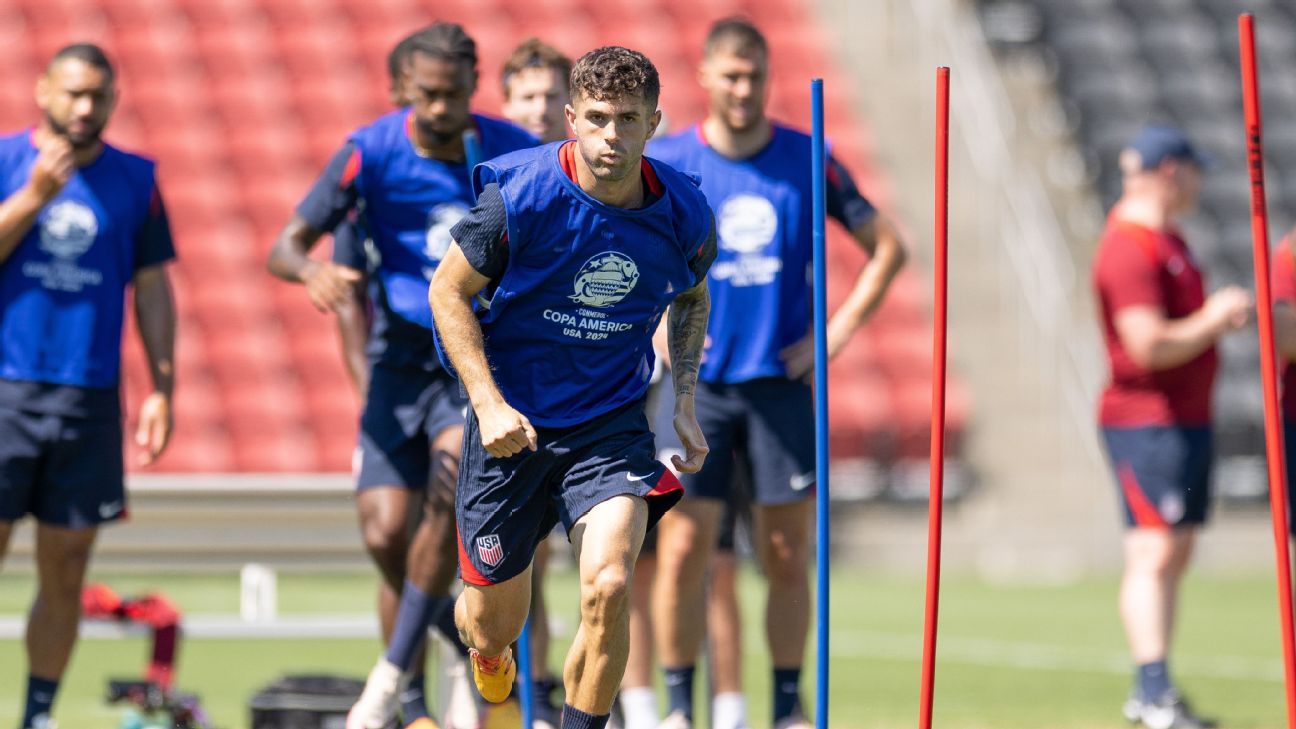Heat-related health incidents keep happening at Copa America. Is enough being done for safety?
Written by I Dig Sports
KANSAS CITY, Missouri -- Assistant referee Humberto Panjoj made it to stoppage of the first half in a Copa America match between Canada and Peru before he fainted. As Canada goalkeeper Maxime Crépeau rushed to see what was wrong, it highlighted an oft overlooked aspect of playing an international soccer tournament in the U.S. during the summer months.
The weather is oppressively hot and humid, and hardly the ideal conditions for such a competition.
The high temperature that day in Kansas City was 93 degrees Fahrenheit, but with a humidity level of 53%, it felt like 103 degrees. Panjoj was admitted to the hospital and discharged a day later, with CONMEBOL officials citing dehydration.
The same was true for Uruguay defender Ronald Araújo, who said he left La Celeste's tournament-opening win against Panama at halftime after he felt "dizzy." He also reportedly suffered from dehydration.
The two incidents highlighted the fact that playing in such extreme conditions carries with it some health risks, and requires multiple layers of preparation, even for professional athletes.
Doug Casa is an expert in exertional heat stroke, and is the CEO of the Korey Stringer Institute. The KSI conducts research into heat and hydration, injury prevention, and strength and conditioning of athletes, laborers and warfighters. Since it opened in 2010, Casa has led the institute, which is named in memory of Korey Stringer, an NFL lineman who died of complications from heat stroke at Minnesota Vikings preseason training camp in 2001.
Casa said that medical personnel have to be especially vigilant when soccer players are playing in hot and humid conditions, given the physical intensity of the sport.
"Soccer is not like baseball or other sports that have built-in breaks," Casa said. "Even American football, we don't have heat strokes during American football games. All the heat strokes in American football, they happen during conditioning and practice. But soccer scares us because people don't have breaks in soccer. It's like 45 minutes -- no break. And besides from the goalie, it's all-out and you're not coming off."
The U.S. men's national team may find itself facing a similar scenario to the Uruguay-Panama game in its group stage finale against Uruguay, though the Americans may catch a break.
There will be some cloud cover during the day, which might serve to lower the temperature. According to the forecast from Accuweather.com, the evening temperature is expected to be 79 degrees. But with a humidity of 73%, it will feel like 85 degrees. Not as oppressive as what Canada and Peru experienced, but not balmy either.
"It'll be brutal because of how high that humidity is," said Casa, who is also a Board of Trustees Distinguished Professor in the Department of Kinesiology at University of Connecticut. "That's extremely high humidity."
Of the two components, the humidity is the most dangerous piece. Casa said that when humidity is high, an athlete's body doesn't effectively cool because, while they're sweating, the sweat's not evaporating. This can lead to dehydration, or more severe forms of heat illness like heat exhaustion or heat stroke.
Competitively, the weather will be the same for both teams, but players handle such conditions in different ways, and will put a premium on keeping their core body temperature down. Given these are elite athletes, the chance of heat-related illness is low, but still possible.
According to a paper co-authored by U.S. Soccer Federation Chief Medical Officer Dr. George Chiampas, who also sits on Concacaf's medical committee, if a player doesn't keep his core body temperature below 102.2 degrees Fahrenheit, not only are they in danger of developing a heat-related illness, but cognitive function can begin to decline. The worry is that could lead to more dangerous plays.
"This raises concerns about the potential impact on the quality of technical decision-making in football-related situations, although direct evidence of such an impact is not yet available," the paper said.
The issues about the heat were known to CONMEBOL prior to the tournament. Chiampas told ESPN that, back in April, he attended a meeting in Paraguay comprised of Copa America team doctors and venue medical coordinators. The purpose was to discuss various health issues ahead of the tournament, including how to cope with the heat.
While economic self-interest on the part of CONMEBOL drove much of the scheduling and venue selection, some of its choices have mitigated the effects of the weather to a degree. Half of the games are being held in indoor venues, while 24 out of the tournament's 32 games are have evening kickoffs of 6 p.m. or later.
That will only get players so far, however. Araujo's match with Uruguay at Hard Rock Stadium in South Florida had a 9 p.m. kickoff. That venue just so happens to be where the final will be held, and both semifinals will be held at outdoor venues, New Jersey's MetLife Stadium and Charlotte's Bank of America Stadium.
So what can the U.S. -- and other teams as well -- do to help its players cope with such conditions?
The mantra for the general public is "stay hydrated," and this holds true for elite athletes as well. But there are some additional steps that can be taken to help them better deal with the elements. It is possible for players to acclimatize themselves to the heat. That requires about 10-14 days of training in those kinds of conditions.
Given that the USMNT has been in camp nonstop since May 28, and has been training in such locales as Orlando, Florida and Dallas, Texas, the players should have adapted to the hot and humid weather by now, even though their first two games have been indoors.
On game day, there are additional steps that can be taken to keep a player's core body temperature down. The warm-up can be adjusted so that it is shorter in duration. Tactics can also be modified to involve less high intensity activities and less distance covered. (Think possession here).
The implementation of cooling breaks midway through each half can also help reduce the impact of hot and humid weather. Such breaks are implemented when the Wet Globe Bulb Temperature -- a measure that takes into account both temperature and humidity -- is above 89 degrees Fahrenheit. The threshold can be even lower if both teams agree that the conditions warrant water breaks being implemented. Players can also be treated with what is called partial body or full body cold water immersion. This is the fastest way to reduce a player's core body temperature. Rehydrating is another pillar to be utilized in terms of keeping players cool.
So will the U.S. adjust their approach to deal with the weather? That will be revealed over time, but, mere moments after Thursday's 2-1 defeat to Panama, U.S. defender Tim Ream said the USMNT is already preparing for the heat.
"The only saving graces that the [Uruguay] game's a little bit later on in the evening, but the sun's still technically up so it'll be difficult," Ream said. "But recovery has already started. We were already recovering in the changing room to be ready to go for the game. It's just something that we'll have to adjust to and see what happens when we get out there."
Looking long term, there is the 2026 World Cup to think about. There will be multiple games on the West Coast, which could mean hotter afternoon kickoffs, though the humidity will be less of a factor in those locations. That said, that aspect of the schedule hasn't been finalized yet.
A FIFA spokesperson told ESPN that the organization is monitoring what is happening at the Copa America regarding heat issues and will attempt to modify its protocols where appropriate.
Casa isn't convinced FIFA is doing enough.
"I don't think the governing bodies invest enough into protecting the athletes during the games -- the cooling strategies, considering modifications to rest breaks, and just be thinking more about athlete safety," he said. "Everything's geared around kind of a fan experience and the generating of dollars, but very little is often focused on the health and safety of the actual athletes and the referees like participating in the game."
More specifically, Casa feels that cooling breaks could either be extended, or scheduled to happen more often. Chiampas noted that medical staff on site do have access to the video feed used by VAR, the better to monitor the players when they get injured. Taking into account the impact of heat is among the scenarios watched.
In the meantime, the U.S. have what is practically a must-win game against Uruguay to prepare for, and they'll have to hope they are prepared for the brutal heat ahead, too.















 Phone: (800) 737. 6040
Phone: (800) 737. 6040 Fax: (800) 825 5558
Fax: (800) 825 5558 Website:
Website:  Email:
Email: 






